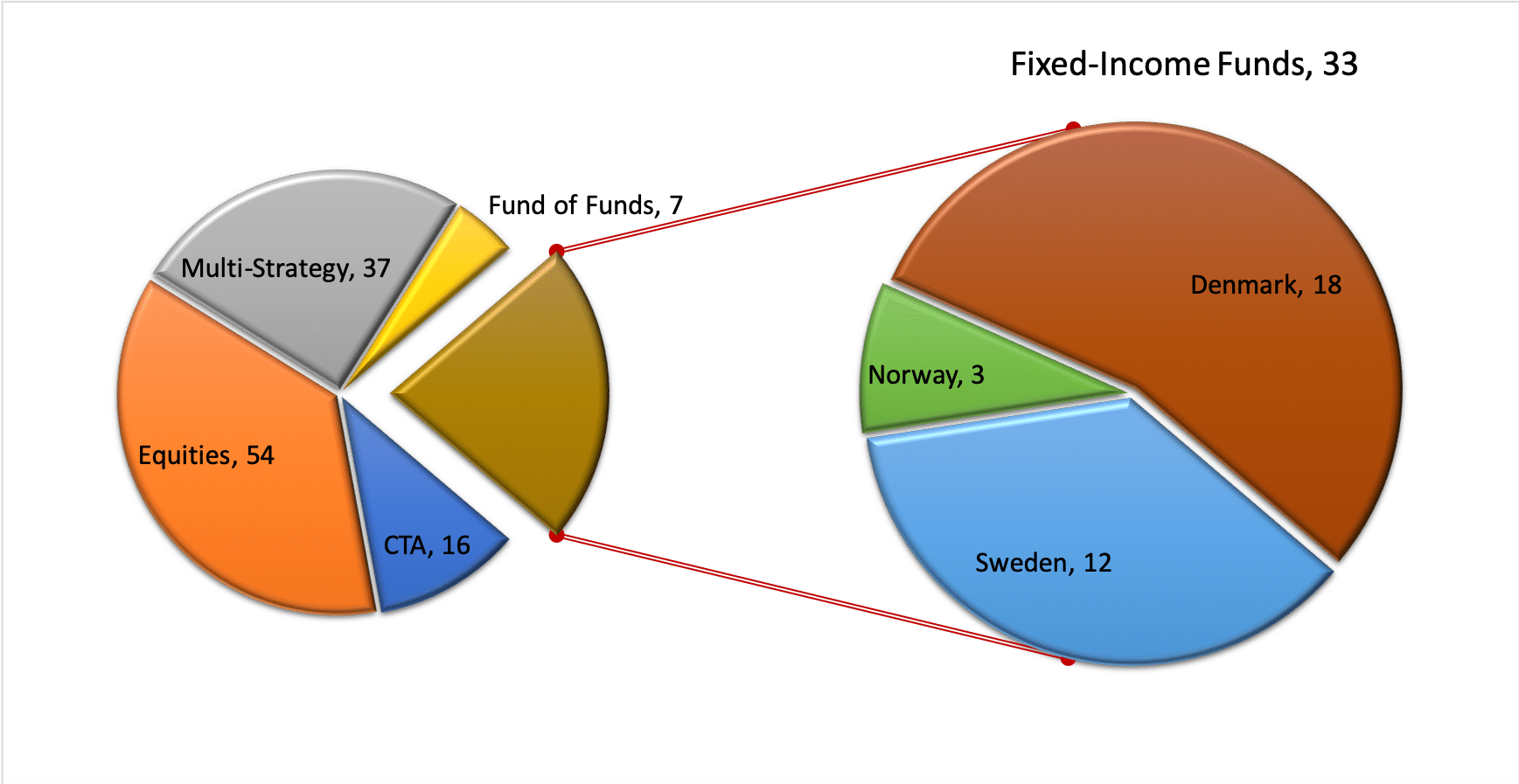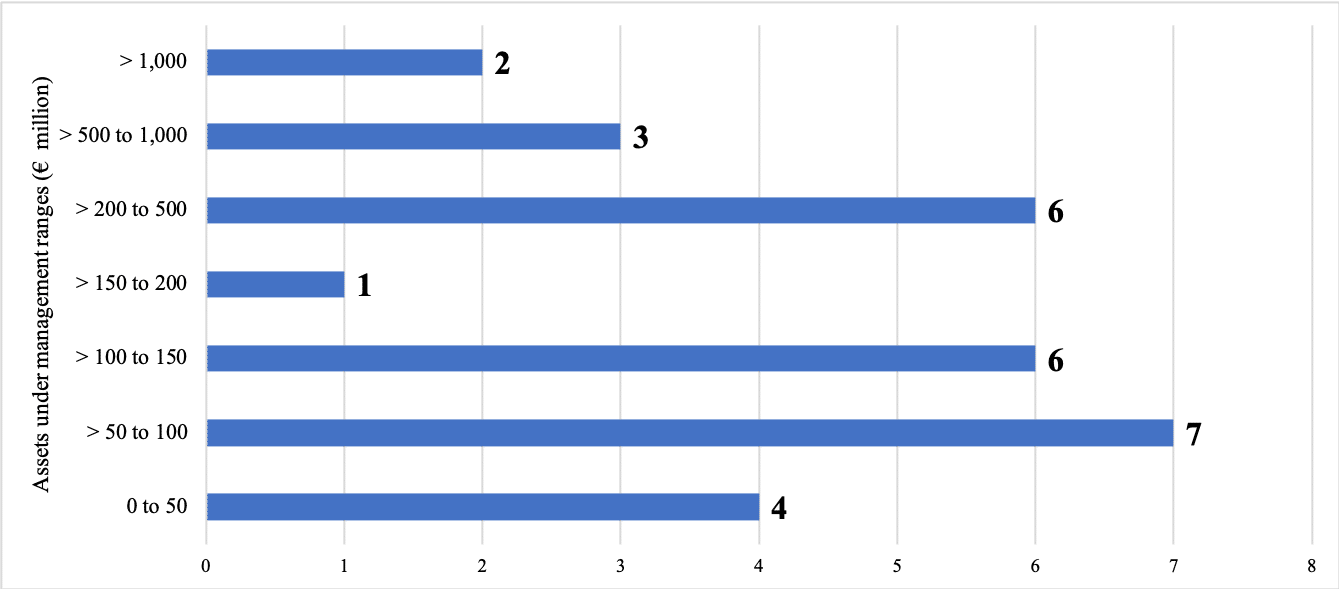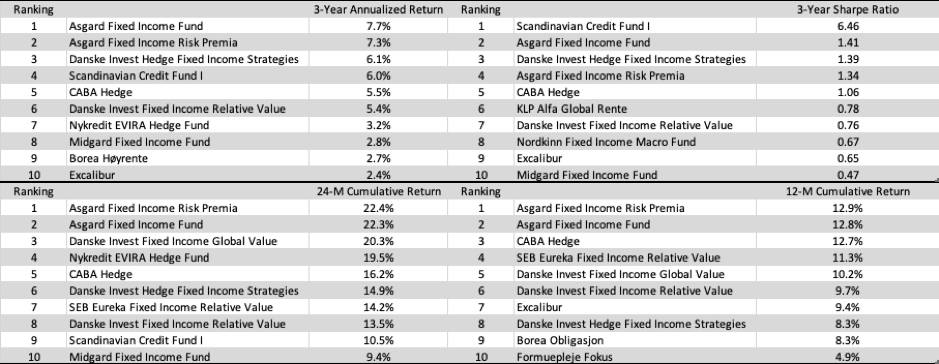Stockholm (HedgeNordic) – When asked to highlight some unique features of the Nordic hedge fund industry, we most often point out that the industry houses several of world’s largest CTA managers and a strong pool of fixed-income hedge funds (mostly Danish but not only). Judging by the statistics provided by the HedgeNordic database, the group of Nordic fixed-income hedge funds is in a very solid and healthy state, especially when comparing to the broader industry. There are a couple of data points backing this statement.
First, eight new fixed-income hedge funds have been launched in the Nordics since the beginning of 2018 and only two funds closed down during the same period. In fact, the “fixed income” category is the only strategy category in the Nordic Hedge Index with new launches outpacing closures since 2018. Second, the collective assets managed by Nordic fixed-income hedge funds increased from around €6.4 billion in December 2017 to €7.3 billion in December of last year, and further increased to €7.8 billion at the end of September this year. Third, fixed-income hedge funds handily outperformed all four remaining strategy categories in the Nordic Hedge Index in the previous 24 months and outperformed all but one strategy category in the past 60 months.
Country of Origination
There are 33 fixed-income hedge funds in the Nordics as of the end of November, compared to 26 at the endof2017,31attheendof2018and32attheend of last year. During 2020, one new fund joined the industry and one vehicle shut its doors. Fixed-income relative value fund Frost was launched by former employees at the now-closed Nektar at the beginning of 2020. SEB Alternative Fixed Income, one of the largest fixed-income hedge funds in the Nordics in recent years, was put into liquidation towards the end of March. 2019 and 2018 were more fruitful in terms of new hedge fund launches in the Nordic fixed-income space. Five new funds were launched and joined the Nordic Hedge Index during 2018 and an additional two funds were launched during 2019. No fixed-income hedge funds closed down in 2018, and only one fund shut its doors last year.

About one in every five active members of the Nordic Hedge Index are classified as fixed-income hedge funds, and more than half of all fixed-income funds are based in Denmark. The Danish mortgage bond market is one of the largest and most liquid bond markets in the world, which partly explains the high number of Danish fixed-income-focused hedge funds. Of the 39 Danish funds in the Nordic Hedge Index, 18 solely focus on investing in the fixed-income space. The Nordic hedge fund industry also includes 12 Swedish fixed-income funds and three Norwegian funds. There are no Finnish fixed-income hedge funds in the Nordic Hedge Index.
Nordic Fixed-Income Hedge Funds Versus the Rest
Nordic fixed-income hedge funds outperformed each of the remaining four strategy categories in the Nordic Hedge Index in the previous 24 months starting from September 2014 and outperformed CTAs, multi-strategy and funds of hedge funds (all but equity hedge funds) over the past 60 months. Furthermore, fixed-income hedge funds are up 2.4 percent on average year-to-date through the end of October, with the group trailing only equity hedge funds this year.
Nordic fixed-income hedge funds, as expressed by the NHX Fixed Income, generated a cumulative return of 6.3 percent in the previous 24 months through the end October, surpassing the 2.9 percent cumulative return delivered by the Nordic Hedge Index. Equity hedge funds, the second best-performing category in the past 24 months, delivered a cumulative return of 5.4 percent during the period.

Over the past 60 months, Nordic fixed-income hedge funds delivered a cumulative return of 23.1 percent on average, whereas equity hedge funds generated a cumulative 30.9 percent. The average Nordic hedge fund, meanwhile, delivered an average cumulative return of 18.8 percent over the past five years through the end of October 2020. International fixed-income hedge funds, as measured by the Eurekahedge Fixed Income Hedge Fund Index, generated a cumulative return of 25.0 percent in the previous 60 months and a cumulative return of 7.9 percent over the past 24 months. The Eurekahedge index currently includes almost 300 constituent funds.
Who’s the Biggest?
The universe of Nordic fixed-income hedge funds oversees €7.79 billion in assets under management as of the end of October based on data from 30 of the 33 members of the NHX Fixed Income. 28 of the 31 fixed- income-focused members of the Nordic Hedge Index that were up and running in December of last year (including the now-closed Trude and SEB Alternative Fixed Income) had €7.77 billion in asset under management at the end of 2019. The current members of the NHX Fixed Income category, which now manage 7.79 billion, had €7.31 billion in assets under management at the end of last year and €5.87 billion at the end of 2017. The fixed-income segment of the Nordic hedge fund industry had €6.44 billion under management at the end of 2017, based on data from 24 fixed-income hedge funds out of the 26 up and running at the time.
At the end of October, Danish-based fixed-income hedge funds collectively managed €4.08 billion of the €7.79 billion, whereas Swedish funds managed €2.89 billion. The three Norwegian fixed-income, two of which are under the umbrella of Borea Asset Management, funds collectively managed a little over €800 million in assets at the end of October.
Danske Bank Asset Management’s suite of four fixed- income hedge funds oversees about €2.5 billion in assets as of the end of October, accounting for 31 percent of the “fixed-income” category’s combined assets. Stockholm-based Nordkinn Fixed Income Macro Fund is the Nordic industry’s largest fixed-income hedge fund with assets under management of €1.14 billion at the end of October. Danske Invest Hedge Fixed Income Strategies closely follows suit with assets under management of €1.08 billion. These are the only fixed-income hedge funds in the HedgeNordic database with assets above €1 billion.
The majority of the Nordic fixed-income hedge funds manage over €100 million in assets (18 of the 29 vehicles with reported assets under management figures). Eleven of these 29 funds manage more than €200 million, and 11 vehicles oversee less than €100 million. Three Nordic fixed-income hedge funds manage between €500 million and €1 billion in capital as of the end of October. As mentioned above, two fixed-income funds from the Nordic Hedge Index manage over €1 billion.

It is worth pointing out that younger fixed-income hedge funds in the Nordics have been relatively successful in attracting capital from investors. The ten Nordic fixed- income funds launched during 2017 or later (with an operating life of less than four years) collectively manage €2.2 billion or €184.7 million on average as of the end of October. The eleven hedge funds started before 2012 (with an operating life of more than ten years) oversee a combined €3.1 billion or €256.8 million on average. The remaining eight mid-age hedge funds started from the beginning of 2012 to the end of 2016, meanwhile, manage €2.5 billion or €310.9 million on average.
The Best Performers
Two funds managed by Copenhagen-based fixed-income manager Moma Advisors achieved the highest annualized return in the past 36 months to the end of October among the funds with a track record of more than three years. Asgard Fixed Income Fund delivered an annualized return of 7.7 percent in the past three years, while Asgard Fixed Income Risk Premia delivered an annualized return of 7.3 percent. Danske Bank Asset Management’s flagship fixed-income fund, Danske Invest Hedge Fixed Income Strategies, followed suit with an annualized return of 6.1 percent. Stockholm-based direct lending fund Scandinavian Credit Fund, meanwhile, achieved a net-of-fees annualized return of 6.0 percent in the past three years to the end of October. Copenhagen-based fixed-income hedge fund CABA Hedge generated an annualized return of 5.5 percent over the same time span.

The two Asgard funds also delivered the highest cumulative returns over the past 24 and 12 months. Looking at risk-adjusted returns over the past three years, Scandinavian Credit Fund achieved a Sharpe ratio of 6.46. Over the past 36 months, Asgard Fixed Income Fund and Danske Invest Hedge Fixed Income Strategies achieved Sharpe ratios of 1.41 and 1.39, respectively. Up and running Nordic fixed-income hedge funds have performed relatively well over time. After all, 13 of the current 33 funds achieved inception-to-date Sharpe ratios above one and 27 of the 33 funds delivered inception-to-date Sharpe ratios of more than 0.5.
Photo by Nik Ramzi Nik Hassan on Unsplash
This article featured in HedgeNordic’s report Alternative Fixed Income Strategies.
